Agribusiness
Agribusiness is the industry, enterprises, and the field of study[1] of value chains in agriculture[2] and in the bio-economy,[3] in which case it is also called bio-business[4][5] or bio-enterprise. The primary goal of agribusiness is to maximize profit while satisfying the needs of consumers for products related to natural resources. Agribusinesses comprise farms, food and fiber processing, forestry, fisheries, biotechnology and biofuel enterprises and their input suppliers.
Studies of business growth and performance in farming have found that successful agricultural businesses are cost-efficient internally and operate in favourable economic, political, and physical-organic environments. They are able to expand and make profits, improve the productivity of land, labor, and capital, and keep their costs down to ensure market price competitiveness.[6]
Agribusiness is not limited to farming. It encompasses a broader spectrum through the agribusiness system which includes input supplies, value-addition, marketing, entrepreneurship, microfinancing, and agricultural extension.
In some countries like the Philippines, creation and management of agribusiness enterprises require consultation with registered agriculturists above a certain level of operations, capitalization, land area, or number of animals in the farm.
Evolution of the agribusiness concept
[edit]The word "agribusiness" is a portmanteau of the words agriculture and business. The earliest known use of the word was in the Volume 155 of the Canadian Almanac & Directory published in 1847.[7] Although most practitioners recognize that it was coined in 1957 by two Harvard Business School professors, John Davis and Ray Goldberg after they published the book "A Concept of Agribusiness."[8]
"Agribusiness is the sum total of all operations involved in the manufacture and distribution of farm supplies; production operations on the farm; and the storage, processing, and distribution of farm commodities and items made from them." (Davis and Goldberg, 1956)
Their book argued against the New Deal programs of then U.S. President Franklin Roosevelt as it led to the increase in agricultural prices. Davis and Goldberg favored corporate-driven agriculture or large-scale farming to revolutionize the agriculture sector, lessening the dependency on state power and politics.[9] They explained in the book that vertically integrated firms within the agricultural value chains have the ability to control prices and where they are distributed.[9] Goldberg then assisted in the establishment of the first undergraduate program in agribusiness in 1966 at the UP College of Agriculture in Los Baños, Philippines as Bachelor of Science in Agriculture major in Agribusiness.[10][11][12] The program was initially a joint undertaking with the UP College of Business Administration in Diliman, Quezon City until 1975.[10] Jose D. Drilon of the University of the Philippines then published the book "Agribusiness Management Resource Materials" (1971) which would be the foundation of current agribusiness programs around the world.[11][13] In 1973, Drilon and Goldberg further expanded the concept of agribusiness to include support organizations such as governments, research institutions, schools, financial institutions, and cooperatives within the integrated Agribusiness System.[14]
Mark R. Edwards and Clifford J. Shultz II (2005) of Loyola University Chicago reframed the definition of agribusiness to emphasize its lack of focus on farm production but towards market centricity and innovative approach to serve consumers worldwide.[15]
"Agribusiness is a dynamic and systemic endeavor that serves consumers globally and locally through innovation and management of multiple value chains that deliver valued goods and services derived from sustainable orchestration of food, fiber and natural resources." (Edwards and Shultz, 2005)
In 2012, Thomas L. Sporleder and Michael A. Boland defined the unique economic characteristics of agribusiness supply chains from industrial manufacturing and service supply chains.[16] They have identified seven main characteristics:
- Risks emanating from the biological nature of agrifood supply chains
- The role of buffer stocks within the supply chain
- The scientific foundation of innovation in production agriculture having shifted from chemistry to biology
- Cyberspace and information technology influences on agrifood supply chains
- The prevalent market structure at the farm gate remains oligopsony
- Relative market power shifts in agrifood supply chains away from food manufacturers downstream to food retailers
- Globalization of agriculture and agrifood supply chains
In 2017, noting the rise of genetic engineering and biotechnology in agriculture, Goldberg further expanded the definition of agribusiness which covers all the interdependent aspects of the food system including medicine, nutrition, and health.[1] He also emphasized the responsibility of agribusiness to be environmentally and socially conscious towards sustainability.[17]
"Agribusiness is the interrelated and interdependent industries in agriculture that supply, process, distribute, and support the products of agriculture." (Goldberg, 2017)
Some agribusinesses have adopted the triple bottom line framework such as aligning for fair trade, organic, good agricultural practices, and B-corporation certifications towards the concept of social entrepreneurship.
Agribusiness system
[edit]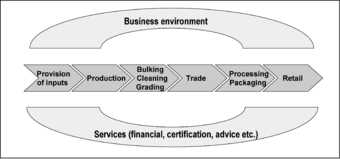
The term value chain was first popularized in a book published in 1985 by Michael Porter,[18] who used it to illustrate how companies could achieve what he called “competitive advantage” by adding value within their organization. Subsequently, the term was adopted for agricultural development purposes [19] and has now become very much in vogue among those working in this field, with an increasing number of bilateral and multilateral aid organisations using it to guide their development interventions.
At the heart of the agricultural value chain concept is the idea of actors connected along a chain producing and delivering goods to consumers through a sequence of activities.[20] However, this “vertical” chain cannot function in isolation and an important aspect of the value chain approach is that it also considers “horizontal” impacts on the chain, such as input and finance provision, extension support and the general enabling environment. The approach has been found useful, particularly by donors, in that it has resulted in a consideration of all those factors impacting on the ability of farmers to access markets profitably, leading to a broader range of chain interventions. It is used both for upgrading existing chains and for donors to identify market opportunities for small farmers.[21]Inputs sector
[edit]Agricultural supplies
[edit]An agricultural supply store or agrocenter is an agriculturally-oriented shop where one sells agricultural supplies — inputs required for agricultural production such as pesticides, feed and fertilizers . Sometimes these stores are organized as cooperatives, where store customers aggregate their resources to purchase agricultural inputs. Agricultural supply and the stores that provide it are part of the larger Agribusiness industry.
Agricultural labor
[edit]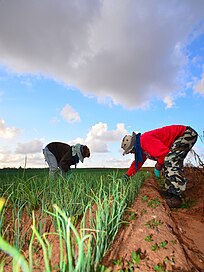

A farmworker, farmhand or agricultural worker is someone employed for labor in agriculture. In labor law, the term "farmworker" is sometimes used more narrowly, applying only to a hired worker involved in agricultural production, including harvesting, but not to a worker in other on-farm jobs, such as picking fruit.
Agricultural work varies widely depending on context, degree of mechanization and crop. In countries like the United States where there is a declining population of American citizens working on farms — temporary or itinerant skilled labor from outside the country is recruited for labor-intensive crops like vegetables and fruits.
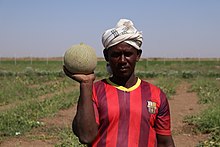

Irrigation
[edit]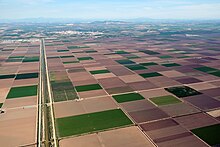
Irrigation (also referred to as watering of plants) is the practice of applying controlled amounts of water to land to help grow crops, landscape plants, and lawns. Irrigation has been a key aspect of agriculture for over 5,000 years and has been developed by many cultures around the world. Irrigation helps to grow crops, maintain landscapes, and revegetate disturbed soils in dry areas and during times of below-average rainfall. In addition to these uses, irrigation is also employed to protect crops from frost,[22] suppress weed growth in grain fields, and prevent soil consolidation. It is also used to cool livestock, reduce dust, dispose of sewage, and support mining operations. Drainage, which involves the removal of surface and sub-surface water from a given location, is often studied in conjunction with irrigation.
There are several methods of irrigation that differ in how water is supplied to plants. Surface irrigation, also known as gravity irrigation, is the oldest form of irrigation and has been in use for thousands of years. In sprinkler irrigation, water is piped to one or more central locations within the field and distributed by overhead high-pressure water devices. Micro-irrigation is a system that distributes water under low pressure through a piped network and applies it as a small discharge to each plant. Micro-irrigation uses less pressure and water flow than sprinkler irrigation. Drip irrigation delivers water directly to the root zone of plants. Subirrigation has been used in field crops in areas with high water tables for many years. It involves artificially raising the water table to moisten the soil below the root zone of plants.
Irrigation water can come from groundwater (extracted from springs or by using wells), from surface water (withdrawn from rivers, lakes or reservoirs) or from non-conventional sources like treated wastewater, desalinated water, drainage water, or fog collection. Irrigation can be supplementary to rainfall, which is common in many parts of the world as rainfed agriculture, or it can be full irrigation, where crops rarely rely on any contribution from rainfall. Full irrigation is less common and only occurs in arid landscapes with very low rainfall or when crops are grown in semi-arid areas outside of rainy seasons.
The environmental effects of irrigation relate to the changes in quantity and quality of soil and water as a result of irrigation and the subsequent effects on natural and social conditions in river basins and downstream of an irrigation scheme. The effects stem from the altered hydrological conditions caused by the installation and operation of the irrigation scheme. Amongst some of these problems is depletion of underground aquifers through overdrafting. Soil can be over-irrigated due to poor distribution uniformity or management wastes water, chemicals, and may lead to water pollution. Over-irrigation can cause deep drainage from rising water tables that can lead to problems of irrigation salinity requiring watertable control by some form of subsurface land drainage.Seeds
[edit]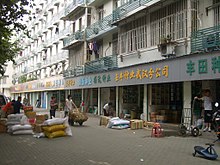
Seed companies produce and sell seeds for flowers, fruits and vegetables to commercial growers and amateur gardeners. The production of seed is a multibillion-dollar global business, which uses growing facilities and growing locations worldwide. While most of the seed is produced by large specialist growers, large amounts are also produced by small growers who produce only one to a few crop types. The larger companies supply seed both to commercial resellers and wholesalers. The resellers and wholesalers sell to vegetable and fruit growers, and to companies who package seed into packets and sell them on to the amateur gardener.
Most seed companies or resellers that sell to retail produce a catalog, for seed to be sown the following spring, that is generally published during early winter. These catalogs are eagerly awaited by the amateur gardener, as during winter months there is little that can be done in the garden so this time can be spent planning the following year’s gardening. The largest collection of nursery and seed trade catalogs in the U.S. is held at the National Agricultural Library where the earliest catalogs date from the late 18th century, with most published from the 1890s to the present.[23]
Seed companies produce a huge range of seeds from highly developed F1 hybrids to open pollinated wild species. They have extensive research facilities to produce plants with genetic materials that result in improved uniformity and appeal. These qualities might include disease resistance, higher yields, dwarf habit and vibrant or new colors. These improvements are often closely guarded to protect them from being utilized by other producers, thus plant cultivars are often sold under the company's own name and protected by international laws from being grown for seed production by others. Along with the growth in the allotment movement, and the increasing popularity of gardening, there have emerged many small independent seed companies. Many of these are active in seed conservation and encouraging diversity. They often offer organic and open pollinated varieties of seeds as opposed to hybrids. Many of these varieties are heirloom varieties. The use of old varieties maintains diversity in the horticultural gene pool. It may be more appropriate for amateur gardeners to use older (heirloom) varieties as the modern seed types are often the same as those grown by commercial producers, and so characteristics which are useful to them (e.g. vegetables ripening at the same time) may be unsuited to home growing.Fertilizers
[edit]
A fertilizer (American English) or fertiliser (British English) is any material of natural or synthetic origin that is applied to soil or to plant tissues to supply plant nutrients. Fertilizers may be distinct from liming materials or other non-nutrient soil amendments. Many sources of fertilizer exist, both natural and industrially produced.[24] For most modern agricultural practices, fertilization focuses on three main macro nutrients: nitrogen (N), phosphorus (P), and potassium (K) with occasional addition of supplements like rock flour for micronutrients. Farmers apply these fertilizers in a variety of ways: through dry or pelletized or liquid application processes, using large agricultural equipment, or hand-tool methods.
Historically, fertilization came from natural or organic sources: compost, animal manure, human manure, harvested minerals, crop rotations, and byproducts of human-nature industries (e.g. fish processing waste, or bloodmeal from animal slaughter). However, starting in the 19th century, after innovations in plant nutrition, an agricultural industry developed around synthetically created agrochemical fertilizers. This transition was important in transforming the global food system, allowing for larger-scale industrial agriculture with large crop yields.
Nitrogen-fixing chemical processes, such as the Haber process invented at the beginning of the 20th century, and amplified by production capacity created during World War II, led to a boom in using nitrogen fertilizers.[25] In the latter half of the 20th century, increased use of nitrogen fertilizers (800% increase between 1961 and 2019) has been a crucial component of the increased productivity of conventional food systems (more than 30% per capita) as part of the so-called "Green Revolution".[26]
The use of artificial and industrially-applied fertilizers has caused environmental consequences such as water pollution and eutrophication due to nutritional runoff; carbon and other emissions from fertilizer production and mining; and contamination and pollution of soil. Various sustainable agriculture practices can be implemented to reduce the adverse environmental effects of fertilizer and pesticide use and environmental damage caused by industrial agriculture.Production sector
[edit]Farming
[edit]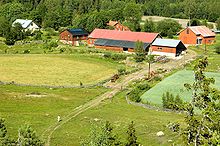
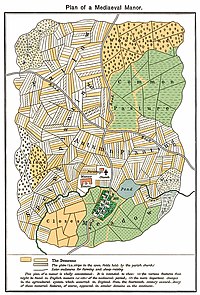
A farm (also called an agricultural holding) is an area of land that is devoted primarily to agricultural processes with the primary objective of producing food and other crops; it is the basic facility in food production.[27] The name is used for specialized units such as arable farms, vegetable farms, fruit farms, dairy, pig and poultry farms, and land used for the production of natural fiber, biofuel, and other commodities. It includes ranches, feedlots, orchards, plantations and estates, smallholdings, and hobby farms, and includes the farmhouse and agricultural buildings as well as the land. In modern times, the term has been extended so as to include such industrial operations as wind farms and fish farms, both of which can operate on land or at sea.
There are about 570 million farms in the world, most of which are small and family-operated. Small farms with a land area of fewer than 2 hectares operate on about 12% of the world's agricultural land, and family farms comprise about 75% of the world's agricultural land.[28]
Modern farms in developed countries are highly mechanized. In the United States, livestock may be raised on rangeland and finished in feedlots, and the mechanization of crop production has brought about a great decrease in the number of agricultural workers needed. In Europe, traditional family farms are giving way to larger production units. In Australia, some farms are very large because the land is unable to support a high stocking density of livestock because of climatic conditions. In less developed countries, small farms are the norm, and the majority of rural residents are subsistence farmers, feeding their families and selling any surplus products in the local market.Farm mechanization
[edit]
Agricultural engineering, also known as agricultural and biosystems engineering, is the field of study and application of engineering science and designs principles for agriculture purposes, combining the various disciplines of mechanical, civil, electrical, food science, environmental, software, and chemical engineering to improve the efficiency of farms and agribusiness enterprises[29] as well as to ensure sustainability of natural and renewable resources.[30]
An agricultural engineer is an engineer with an agriculture background. Agricultural engineers make the engineering designs and plans in an agricultural project, usually in partnership with an agriculturist who is more proficient in farming and agricultural science.Processing sector
[edit]Primary processing
[edit]
Primary food processing turns agricultural products, such as raw wheat kernels or livestock, into something that can eventually be eaten. This category includes ingredients that are produced by ancient processes such as drying, threshing, winnowing and milling grain, shelling nuts, and butchering animals for meat.[31][32] It also includes deboning and cutting meat, freezing and smoking fish and meat, extracting and filtering oils, canning food, preserving food through food irradiation, and candling eggs, as well as homogenizing and pasteurizing milk.[32][33][34]
Contamination and spoilage problems in primary food processing can lead to significant public health threats, as the resulting foods are used so widely.[32] However, many forms of processing contribute to improved food safety and longer shelf life before the food spoils.[33] Commercial food processing uses control systems such as hazard analysis and critical control points (HACCP) and failure mode and effects analysis (FMEA) to reduce the risk of harm.[32]Secondary processing
[edit]
Marketing sector
[edit]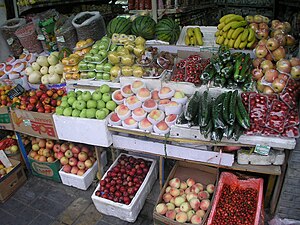
Farmers' market
[edit]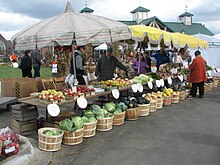
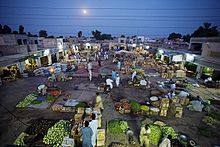

A farmers' market (or farmers market according to the AP stylebook,[36][37] also farmer's market in the Cambridge Dictionary[38][39]) is a physical retail marketplace intended to sell foods directly by farmers to consumers. Farmers' markets may be indoors or outdoors and typically consist of booths, tables or stands where farmers sell their produce, live animals and plants, and sometimes prepared foods and beverages. Farmers' markets exist in many countries worldwide and reflect the local culture and economy. The size of the market may be just a few stalls or it may be as large as several city blocks. Due to their nature, they tend to be less rigidly regulated than retail produce shops.[40]
They are distinguished from public markets, which are generally housed in permanent structures, open year-round, and offer a variety of non-farmer/non-producer vendors, packaged foods and non-food products.[41][42]Support sector
[edit]Education
[edit]Agricultural extension is the application of scientific research and new knowledge to agricultural practices through farmer education. The field of 'extension' now encompasses a wider range of communication and learning activities organized for rural people by educators from different disciplines, including agriculture, agricultural marketing, health, and business studies.
Extension practitioners can be found throughout the world, usually working for government agencies. They are represented by several professional organizations, networks and extension journals.
Agricultural extension agencies in developing countries receive large amounts of support from international development organizations such as the World Bank and the Food and Agriculture Organization of the United Nations.Cooperatives
[edit]
An agricultural cooperative, also known as a farmers' co-op, is a producer cooperative in which farmers pool their resources in certain areas of activities.
A broad typology of agricultural cooperatives distinguishes between agricultural service cooperatives, which provide various services to their individually-farming members, and agricultural production cooperatives in which production resources (land, machinery) are pooled and members farm jointly.[43]
Notable examples of agricultural cooperatives include Dairy Farmers Of America, the largest dairy company in the US,[44] Amul, the largest food product marketing organization in India[45] and Zen-Noah, a federation of agricultural cooperatives that handles 70% of the sales of chemical fertilizers in Japan.[46]
The default meaning of "agricultural cooperative" in English is usually an agricultural service cooperative, the numerically dominant form in the world. There are two primary types of agricultural service cooperatives: supply cooperatives and marketing cooperatives. Supply cooperatives supply their members with inputs for agricultural production, including seeds, fertilizers, fuel, and machinery services. Marketing cooperatives are established by farmers to undertake transportation, packaging, pricing, distribution, sales and promotion of farm products (both crop and livestock). Farmers also widely rely on credit cooperatives as a source of financing for both working capital and investments.Governments
[edit]

The Food and Agriculture Organization of the United Nations[47] (FAO) is a specialized agency of the United Nations that leads international efforts to defeat hunger and improve nutrition and food security. Its Latin motto, fiat panis, translates to "let there be bread". It was founded on 16 October 1945.[48]
The FAO comprises 195 members, including 194 countries and the European Union. Its headquarters is in Rome, Italy, and it maintains regional and field offices worldwide, operating in over 130 countries.[49] It helps governments and development agencies coordinate their activities to improve and develop agriculture, forestry, fisheries, and land and water resources. It also conducts research, provides technical assistance to projects, operates educational and training programs, and collects agricultural output, production, and development data.[49]
The FAO is governed by a biennial conference representing each member country and the European Union, which elects a 49-member executive council.[50] The director-general, as of 2019 Qu Dongyu of China, serves as the chief administrative officer.[51] Various committees govern matters such as finance, programs, agriculture, and fisheries.[52]
| 100 lire (FAO's celebration.) | |
|---|---|

| |
| Obverse: Young woman with braid facing left. Surrounded by Repubblica Italiana [Italian Republic]. | Reverse: Cow nursing calf, face value & date. FAO at bottom and Nutrire il Mondo [Feed the world] at top. |
| Coin minted by Italy in the 1970s to celebrate and promote the Food and Agriculture Organization. | |
Professionals
[edit]
An agriculturist, agriculturalist, agrologist, or agronomist (abbreviated as agr.) is a professional in the science, practice, and management of agriculture and agribusiness.[53] It is a regulated profession in Canada, India, the Philippines, the United States, and the European Union. Other names used to designate the profession include agricultural scientist, agricultural manager, agricultural planner, agriculture researcher, or agriculture policy maker.
The primary role of agriculturists are in leading agricultural projects and programs, usually in agribusiness planning or research for the benefit of farms, food, and agribusiness-related organizations.[54] Agriculturists usually are designated in the government as public agriculturists serving as agriculture policymakers or technical advisors for policy making.[55] Agriculturists can also provide technical advice for farmers and farm workers such as in making crop calendars and workflows to optimize farm production, tracing agricultural market channels,[56] prescribing fertilizers and pesticides to avoid misuse,[57] and in aligning for organic accreditation[58] or the national agricultural quality standards.[59]
Preparation of technical engineering designs and construction for agriculture meanwhile are reserved for agricultural engineers.[60] Agriculturists may pursue environmental planning and focus on agricultural and rural planning.[61]Studies and reports
[edit]Studies of agribusiness often come from the academic fields of agricultural economics and management studies, sometimes called agribusiness management.[2] To promote more development of food economies, many government agencies support the research and publication of economic studies and reports exploring agribusiness and agribusiness practices. Some of these studies are on foods produced for export and are derived from agencies focused on food exports. These agencies include the Foreign Agricultural Service (FAS) of the U.S. Department of Agriculture, Agriculture and Agri-Food Canada (AAFC), Austrade, and New Zealand Trade and Enterprise (NZTE).
The Federation of International Trade Associations publishes studies and reports by FAS and AAFC, as well as other non-governmental organizations on its website.[62]
In their book A Concept of Agribusiness,[8] Ray Goldberg and John Davis provided a rigorous economic framework for the field. They traced a complex value-added chain that begins with the farmer's purchase of seed and livestock and ends with a product fit for the consumer's table. Agribusiness boundary expansion is driven by a variety of transaction costs.[citation needed]
As concern over global warming intensifies, biofuels derived from crops are gaining increased public and scientific attention. This is driven by factors such as oil price spikes, the need for increased energy security, concern over greenhouse gas emissions from fossil fuels, and support from government subsidies. In Europe and in the US, increased research and production of biofuels have been mandated by law.[63]
See also
[edit]- Agrarian law
- Agrarian reform
- Agribusiness in Kenya
- Agricultural machinery industry
- Agricultural marketing
- Agricultural value chain
- Agroecology
- Animal–industrial complex
- Biofuel
- Contract farming
- Energy crop
- Energy law
- Environmental impact of agriculture
- Factory farming
- Industrial agriculture
- Land banking
- Pharming (genetics)
References
[edit]Citations
[edit]- ^ a b Ward, Natalee (2017-05-25). "Ray Goldberg: The man that coined the term "agribusiness"". www.weeklytimesnow.com.au. Archived from the original on 2021-05-02. Retrieved 2021-05-02.
- ^ a b Ng, Desmond; Siebert, John W. (2009). "Toward Better Defining the Field of Agribusiness Management" (PDF). International Food and Agribusiness Management Review. 12 (4).
- ^ Adamowicz, Mieczysław (2020). "Bioeconomy As a Concept for The Development of Agriculture and Agribusiness". Problems of Agricultural Economics. 365: 135–155. doi:10.30858/zer/131842. ISSN 0044-1600. S2CID 234433508.
- ^ Heijman, Wim (2016-06-01). "How big is the bio-business? Notes on measuring the size of the Dutch bio-economy". NJAS: Wageningen Journal of Life Sciences. 77: 5–8. doi:10.1016/j.njas.2016.03.004. ISSN 1573-5214. S2CID 156714858.
- ^ "Curriculum|TOKYO UNIVERSITY OF AGRICULTURE". www.nodai.ac.jp. Retrieved 2021-05-02.
- ^ "Agricultural businesses: Key influences on growth and performance", in Agricultural Businesses: Their Growth & Performance, ISR/Google Books, 2022. ISBN 9780906321782
- ^ Canadian Almanac & Directory. Copp Clark Publishing Company. 1847. ISBN 978-1-895021-81-3.
- ^ a b Davis, John H.; Goldberg, Ray A. (1957). A Concept of Agribusiness. Division of Research, Graduate School of Business Administration, Harvard University. ISBN 9781684225248.
- ^ a b Hamilton, Shane (2016). "Revisiting the History of Agribusiness". Business History Review. 90 (3): 541–545. doi:10.1017/S000768051600074X. ISSN 0007-6805. S2CID 157756414.
- ^ a b "Academic Programs". 2015-05-03. Archived from the original on 2015-05-03. Retrieved 2021-05-02.
- ^ a b Desai, D.K. (October 1974). "Evolution of a Concept of Agribusiness and its Application" (PDF). Indian Journal of Agricultural Economics. XXIX (4): 32–43.
- ^ "Department of Agribusiness Management and Entrepreneurship". College of Economics and Management. 14 November 2019. Retrieved 2021-05-02.
- ^ Drilon, Jose D. (1971). Agribusiness Management Resource Materials: Introduction to agribusiness management. Asian Productivity Organization. ISBN 978-92-833-1009-9.
- ^ Desai, D. K. (August 1973). "Planning a Progressive Agricultural Infrastructure". 1973 Conference, August 19–30, 1973, São Paulo, Brazil.
- ^ Shultz, Clifford J.; Edwards, Mark R. "Reframing Agribusiness: Moving from Farm to Market Centric". Journal of Agribusiness. 23 (1): 57–73.
- ^ Sporleder, Thomas L.; Boland, Michael A. (2011). "Exclusivity of Agrifood Supply Chains: Seven Fundamental Economic Characteristics" (PDF). International Food and Agribusiness Management Review. 14: 27–52.
- ^ HBS Professor Ray Goldberg on the History of Sustainable Agribusiness, 11 May 2015, archived from the original on 2021-12-12, retrieved 2021-05-02
- ^ Porter, Michael E. (1998). Competitive advantage: creating and sustaining superior performance; with a new introduction (1st Free Press ed.). New York: Free Press. ISBN 978-0684841465.
- ^ Kaplinsky, R.; Morris, M. "A Handbook for Value Chain Analysis" (PDF). IDRC. Archived from the original (PDF) on 1 March 2014. Retrieved 24 February 2014.
- ^ Henriksen, L.; L. Riisgaard; S. Ponte; F. Hartwich; P. Kormawa. "Agro-Food Value Chain Interventions in Asia: A review and analysis of case studies. Working Paper" (PDF). UNIDO. Archived from the original (PDF) on 1 March 2014. Retrieved 24 February 2014.
- ^ "Editorial: Adding Value, by Michael Hailu, Spore No 157". Archived from the original on 2021-02-26. Retrieved 2014-02-25.
- ^ Snyder, R. L.; Melo-Abreu, J. P. (2005). Frost protection: fundamentals, practice, and economics. Vol. 1. Food and Agriculture Organization of the United Nations. ISBN 978-92-5-105328-7. ISSN 1684-8241.
- ^ "Guide to the Collections: Henry G. Gilbert Nursery and Seed Trade Catalog Collection." National Agricultural Library, Special Collections. Retrieved April 23, 2009.
- ^ Scherer, Heinrich W.; Mengel, Konrad; Kluge, Günter; Severin, Karl (2009). "Fertilizers, 1. General". Ullmann's Encyclopedia of Industrial Chemistry. Weinheim: Wiley-VCH. doi:10.1002/14356007.a10_323.pub3. ISBN 978-3527306732.
- ^ "Fritz Haber". Science History Institute. 2016-06-01. Retrieved 2022-12-16.
- ^ Mbow et al. 2019.
- ^ Gregor, 209; Adams, 454.
- ^ Lowder, Sarah K.; Skoet, Jakob; Raney, Terri (2016). "The Number, Size, and Distribution of Farms, Smallholder Farms, and Family Farms Worldwide". World Development. 87: 16–29. doi:10.1016/j.worlddev.2015.10.041.
- ^ "ASABE". asabe.org. Retrieved 2018-04-13.
- ^ "Agricultural and Biosystems Engineering | Professional Regulation Commission". prc.gov.ph. Retrieved 2021-05-01.
- ^ Grumezescu, Alexandru Mihai; Holban, Alina Maria (2018-04-08). Food Processing for Increased Quality and Consumption. Academic Press. p. 430. ISBN 9780128114995.
- ^ a b c d e Hitzmann, Bernd (2017-08-11). Measurement, Modeling and Automation in Advanced Food Processing. Springer. pp. 30–32. ISBN 9783319601113.
- ^ a b Ionescu, Gabriela (2016-05-25). Sustainable Food and Beverage Industries: Assessments and Methodologies. CRC Press. p. 21. ISBN 9781771884112.
- ^ a b US Congress, Office of Technology Assessment (June 1987). "Chapter 8, Technologies Supporting Agricultural, Aquacultural, and Fisheries Development". Integrated Renewable Resource Management for U.S. Insular Areas: Summary. Washington, DC: US Government Printing Office. pp. 278–281. ISBN 9781428922792.
- ^ Hui, Y. H. (2012-01-11). Handbook of Meat and Meat Processing, Second Edition. CRC Press. p. 599. ISBN 9781439836835.
- ^ "AP Style tip: farmers market or farmer's market?". Twitter. AP Stylebook. 30 April 2014. Archived from the original on 3 September 2021. Retrieved 30 January 2022.
- ^ "AP Style tip: farmers market or farmer's market?". Facebook. AP Stylebook. 30 April 2014. Retrieved 30 January 2022.
- ^ "FARMER'S MARKET | meaning in the Cambridge English Dictionary". Cambridge Dictionary. 30 January 2022. Archived from the original on 30 January 2022. Retrieved 30 January 2022.
- ^ "MARKET | meaning in the Cambridge English Dictionary". Cambridge Dictionary. 30 January 2022. Archived from the original on 20 January 2022. Retrieved 30 January 2022.
- ^ Denne, Luke; Foxcroft, Tiffany (29 September 2017). "'People are being duped': CBC exposes homegrown lies at farmers markets". CBC News. Canadian Broadcasting Corporation. Archived from the original on 10 October 2019. Retrieved 15 November 2017.
- ^ Bell, Randy (29 August 2013). "Public markets differ from farmers markets". MSU Extension. Michigan State University. Archived from the original on 26 February 2018. Retrieved 11 January 2021.
- ^ "The Difference Between Public Markets and Farmers Markets". Charlotte, NC USA: 7th Street Public Market. Archived from the original on 7 April 2014.
- ^ Cobia, David, editor, Cooperatives in Agriculture, Prentice-Hall, Englewood Cliffs, NJ (1989), p. 50.
- ^ "Dairy Industries International" (PDF).
- ^ "India's Amul: Keeping Up with the Times - Case - Faculty & Research - Harvard Business School". www.hbs.edu. Retrieved 2024-02-01.
- ^ Béla A. Balassa; Marcus Noland. Japan in the World Economy. p. 228.
- ^ French: Organisation des Nations unies pour l'alimentation et l'agriculture; Italian: Organizzazione delle Nazioni Unite per l'alimentazione e l'agricoltura.
- ^ "Food and Agriculture Organization | United Nations organization". Encyclopedia Britannica. Retrieved 31 December 2019.
- ^ a b "About FAO". Food and Agriculture Organization of the United Nations. Retrieved 31 December 2019.
- ^ "List of FAO members". fao.org. Archived from the original on 20 August 2019. Retrieved 15 October 2010.
- ^ "Leadership | Food and Agriculture Organization of the United Nations". www.fao.org. Retrieved 31 December 2019.
- ^ "GSB: Home page". www.fao.org. Retrieved 31 December 2019.
- ^ "Agriculturist". ble.dole.gov.ph. Archived from the original on 2021-04-30. Retrieved 2021-04-30.
- ^ "Agriculture | Professional Regulation Commission". www.prc.gov.ph. Retrieved 2021-04-30.
- ^ "Qualification Standards for Agriculturist Position" (PDF). Civil Service Commission. Archived (PDF) from the original on 2016-06-15.
- ^ "Agribusiness and Marketing Assistance". Department of Agriculture. Archived from the original on 2017-07-06.
- ^ "PD 1144 - Fertilizer and Pesticide Authority". fpa.da.gov.ph. Retrieved 2021-05-02.
- ^ "Organic Agriculture Program". Archived from the original on 2018-09-07.
- ^ "BAFS | Bureau of Agriculture and Fisheries Standards". 2021-01-18. Archived from the original on 2021-01-18. Retrieved 2021-05-02.
- ^ "Agricultural and Biosystems Engineering | Professional Regulation Commission". www.prc.gov.ph. Retrieved 2021-05-02.
- ^ "Rural Planning". Queensland Farmers' Federation. 2016-11-01. Retrieved 2021-11-19.
- ^ "What is Agribusiness in 2023". farmingagri.com. Archived from the original on 2018-06-27. Retrieved 2013-05-02.
- ^ "Backpedaling on Biofuels". Wild.org. 2008-08-01. Archived from the original on 2012-09-19. Retrieved 2013-05-02.
Cited sources
[edit]- Mbow, Cheikh; Rosenzweig; Barioni, Luis .G.; Benton, Tim .G. (2019). "Food security". In Shukla, P.R.; Skea, J.; Buendia, E. Calvo; Masson-Delmotte, V. (eds.). Climate Change and Land: an IPCC special report on climate change, desertification, land degradation, sustainable land management, food security, and greenhouse gas fluxes in terrestrial ecosystems. IPCC.
Further reading
[edit]- Wilkinson, John. "The Globalization of Agribusiness and Developing World Food Systems". Monthly Review.
- Gitta, Cosmas and South, David (2012). Southern Innovator Magazine Issue 3: Agribusiness and Food Security: United Nations Office for South-South Cooperation. ISSN 2222-9280
- https://web.archive.org/web/20160304034828/http://www.ifama.org/files/IS_Ledesma_Formatted.pdf
